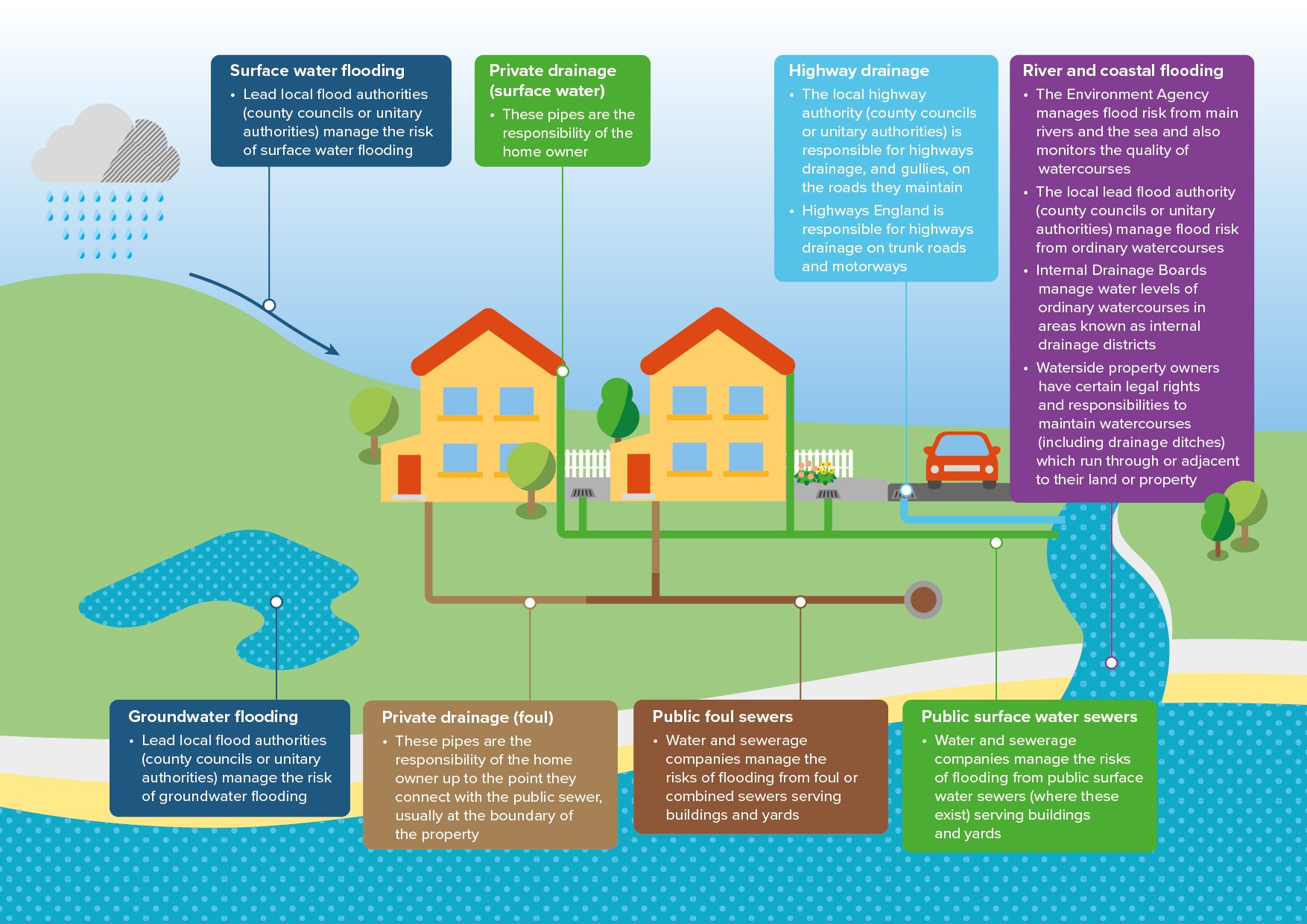Flooding – who’s responsible?
The answer isn’t straightforward. It’s not just one organisation who’s responsible for dealing with and preventing floods.
As a wastewater company, we're not responsible for investigating groundwater, river flooding or surface water problems. This is the role of other agencies. It’s our responsibility to ensure our customers can continue to use their wastewater services.
Our priority is to keep our sewers flowing and manage the flows they are built to carry, such as waste from toilets, sinks, showers and washing machines, as well as rainwater from roofs and driveways.
Southern Water’s responsibilities around floods
The part we play is around the wastewater function of what we do. So that’s all the water that ends up in your drains (water from toilets, taps, appliances and run-off rainwater) that we take away from your home via the sewage system. Our job – when it comes to preventing flooding – is to manage those sewers so the contents continue to flow through them.

Why do wastewater floods happen?
No matter how hard we try, the twin impact of increasing population and climate change mean our sewers sometimes struggle to handle the millions of litres of floodwater that pass through it. But, most of the time, it’s a block in the sewer that’s the culprit.
We work closely with a host of other organisations – who also have a part to play – to prevent flooding. Have a look at the picture below to get an idea of who is responsible for what and where we fit in.
Who’s responsible for putting everything right after a flood?
After flooding, some recovery activities are the responsibility of water companies and some the responsibility of other agencies.
The list below shows who handles different aspects of flood recovery:
Cleaning up public areas
- Replacing missing or dislodged manholes: Water companies
- Controlling access to water hydrant use: Water companies
- Removing silt and sewer debris from public sewers and pumping stations: Water companies
- Washing silt and sewer debris from streets: Highways Authority
- Cleaning highway debris, gullies and drainage ditches: Highways Authority
- Washing and removing silt and sewer debris from open spaces: Local authority
- Removing litter from watercourses: Environment Agency
- Pumping flood water from public areas: Environment Agency
- Disposing of flood-damaged property: Local authority
- Removing sandbags: Local authority
Cleaning up properties
If your property has been flooded by water from our sewers we'll clean up as soon as possible. It's also important to contact your insurers, who may agree to make alternative clean-up arrangements.
For all other flooding use the list below:
- Internal cleaning of insured properties: Insurance companies
- Internal cleaning of non-insured properties: Private owners
- External cleaning (e.g. gardens and drives) of insured properties: Insurance companies
- External cleaning (e.g. gardens and drives) of non-insured properties: Private owners
- Providing dehumidifiers or driers to insured properties: Insurance companies
- Providing dehumidifiers or driers to non-insured properties: Private owners
- Restoring septic tanks: Private owners
- Pumping out flooded properties: Insurance companies and private owners
- Restoring allotments and food crops: Insurance companies and private owners
Restoring utilities
- Restoring free-flowing public sewers: Water companies
- Restoring public wastewater pumping stations: Water companies
- Restoring internal electricity to insured properties: Insurance companies and private owners
- Restoring internal electricity to non-insured properties: Private owners
- Restoring telecoms: Telecoms companies
- Restoring gas supply: Gas companies
- Restoring electricity to property meter or fuse box: Electricity companies
- Restoring free-flowing private drainage: Private owners
- Restoring private wastewater pumping stations: Private owners
- Assessing the impact of flooding on roads, footpaths and rail:
Water companies, Environment Agency, Highway Authority, local authority, electricity companies, gas companies, telecoms companies
Handling groundwater flooding
- Preventing groundwater flooding: Local authority
- Approving the pumping of groundwater into watercourses: Environment Agency
Welfare during recovery
- Providing and maintaining toilet facilities: Local authority
- Providing accommodation for displaced residents during clean-up: Insurance companies, local authority, private owners
- Security for property: Police
Communications
- Providing sewer flooding advice leaflets: Water companies
- Chairing strategic recovery group and local meetings: Local authority
- Sourcing suitable location and welfare for recovery teams: Local authority
- Local co-ordination of agencies: Local authority
- Giving insurance advice: Insurance companies
- Providing health leaflets: Local authority
Tankering
We respond to such emergencies by ‘tankering’ – pumping wastewater from a sewer into a tanker lorry and taking it away for treatment.
This helps to keep the sewers flowing, so they can deal with the wastewater from homes and businesses – the job they are designed to do – and helps protect customers' properties from being flooded internally.
Over-pumping
Where more help is needed, we carry out over-pumping. This involves pumping heavily-diluted wastewater from sewers through a screening system before releasing it into nearby rivers, streams or ditches.
Over-pumping is necessary to protect properties and can move large volumes of water quickly – roughly 50 to 60 litres a second compared with a couple of litres a second for a tanker.
Biological treatment tanks will improve the quality of the floodwater pumped from our sewers.
Treatment tanks
Working with Atac Solutions Limited, we developed new transportable biological treatment tanks. These use bacteria to treat the water from our pumps on site before it is recycled to local watercourses.
Each tank can improve the quality of the water we treat by as much as 40%. They also allow more oxygen to be applied during the treatment process which helps maintain the natural balance of rivers for local wildlife.